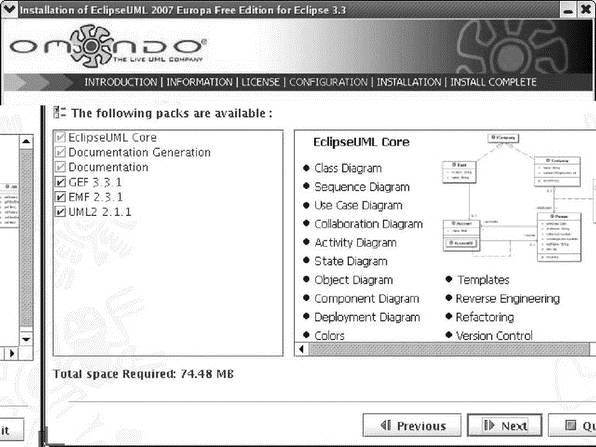Книга: Embedded Linux development using Eclipse
8.1.1 Installing Omondo EclipseUML
8.1.1 Installing Omondo EclipseUML
Eclipse.org does not itself have a complete UML plug-in. Instead, we’ll use a free plugin offered by Omondo, a UML tool vendor. EclipseUML Free Edition supports all UML 2.1 diagrams and is a good package for exploring what UML is all about.
The EclipseUML download page is: http://www.eclipsedownload.com/download_free_eclipse_3.3.html. There are three distributions available. For our purposes, the correct one is the EclipseUML Free Installer for Windows and Linux. It’s a jar file. Download it to your workstation.
Make sure Eclipse is not running, and in a shell window execute:[11]
java –jar eclipseUML_E330_2007_freeEdition_3.3.0.v20071210.jar
This brings up an installation dialog. The first step is to select a language and click OK. Click Next to exit the welcome screen. The next screen is a little confusing in its description of system requirements. It says that three Eclipse plug-ins are required for EclipseUML and implies that one of them, Graphical Editor Framework, is included. In fact, all three of the required plug-ins are included.
Click Next and accept the license terms. The next screen shows your Eclipse installation path. Click Next again. This brings up the configuration screen of Figure 8.1. Leave all six items checked. Click Next and the installation begins. The installer creates an uninstall script should you wish to remove EclipseUML later.

Figure 8.1: EclipseUML configuration screen.
To confirm that the installation succeeded, select Window?Preferences. UML should show up in the left-hand navigation panel.
- 8.1.6 Configuring EclipseUML
- Chapter 5 Installing and Configuring VirtualCenter 2.0
- CHAPTER 1 Installing Fedora
- Installing from CD or DVD
- Installing Using a Network
- Choosing, Configuring, and Installing the Boot Loader
- Installing and Configuring OpenOffice.org
- Installing Proprietary Video Drivers
- Installing Popular Games in Fedora
- Installing Xen
- Installing the Apache Server
- Installing Through Pirut




